2004 CHEVROLET SILVERADO AIR
[x] Cancel search: AIRPage 55 of 584
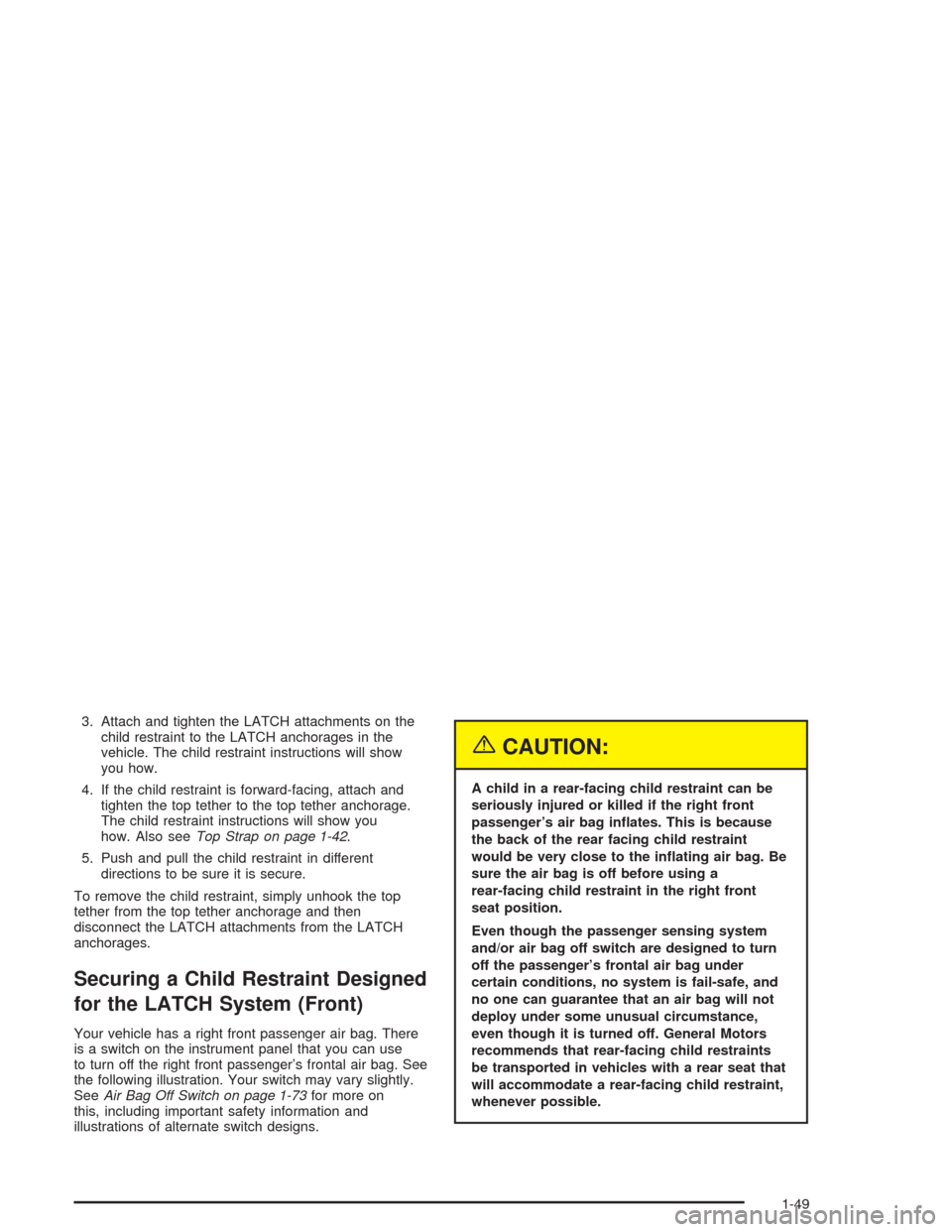
3. Attach and tighten the LATCH attachments on the
child restraint to the LATCH anchorages in the
vehicle. The child restraint instructions will show
you how.
4. If the child restraint is forward-facing, attach and
tighten the top tether to the top tether anchorage.
The child restraint instructions will show you
how. Also seeTop Strap on page 1-42.
5. Push and pull the child restraint in different
directions to be sure it is secure.
To remove the child restraint, simply unhook the top
tether from the top tether anchorage and then
disconnect the LATCH attachments from the LATCH
anchorages.
Securing a Child Restraint Designed
for the LATCH System (Front)
Your vehicle has a right front passenger air bag. There
is a switch on the instrument panel that you can use
to turn off the right front passenger’s frontal air bag. See
the following illustration. Your switch may vary slightly.
SeeAir Bag Off Switch on page 1-73for more on
this, including important safety information and
illustrations of alternate switch designs.
{CAUTION:
A child in a rear-facing child restraint can be
seriously injured or killed if the right front
passenger’s air bag in�ates. This is because
the back of the rear facing child restraint
would be very close to the in�ating air bag. Be
sure the air bag is off before using a
rear-facing child restraint in the right front
seat position.
Even though the passenger sensing system
and/or air bag off switch are designed to turn
off the passenger’s frontal air bag under
certain conditions, no system is fail-safe, and
no one can guarantee that an air bag will not
deploy under some unusual circumstance,
even though it is turned off. General Motors
recommends that rear-facing child restraints
be transported in vehicles with a rear seat that
will accommodate a rear-facing child restraint,
whenever possible.
1-49
Page 56 of 584
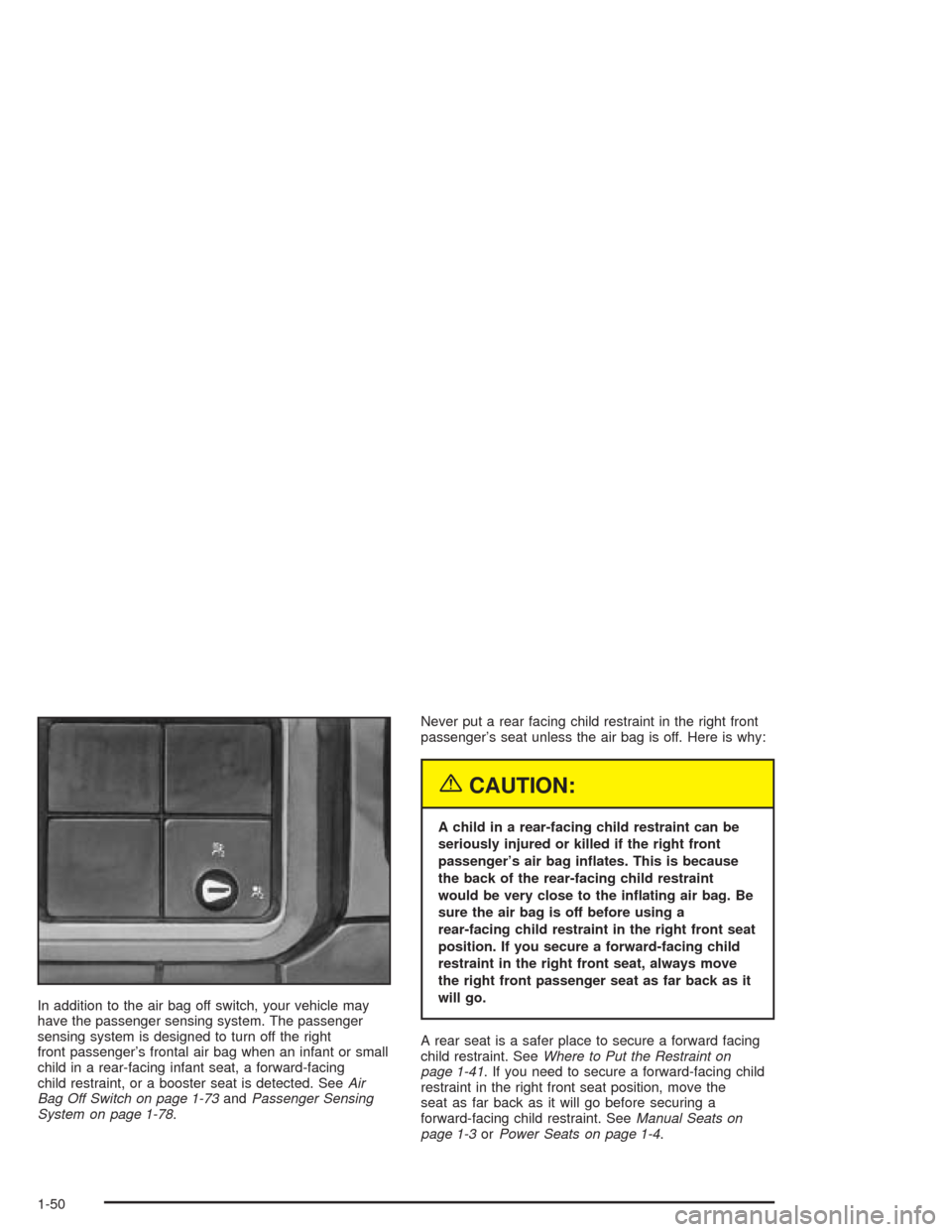
In addition to the air bag off switch, your vehicle may
have the passenger sensing system. The passenger
sensing system is designed to turn off the right
front passenger’s frontal air bag when an infant or small
child in a rear-facing infant seat, a forward-facing
child restraint, or a booster seat is detected. SeeAir
Bag Off Switch on page 1-73andPassenger Sensing
System on page 1-78.Never put a rear facing child restraint in the right front
passenger’s seat unless the air bag is off. Here is why:
{CAUTION:
A child in a rear-facing child restraint can be
seriously injured or killed if the right front
passenger’s air bag in�ates. This is because
the back of the rear-facing child restraint
would be very close to the in�ating air bag. Be
sure the air bag is off before using a
rear-facing child restraint in the right front seat
position. If you secure a forward-facing child
restraint in the right front seat, always move
the right front passenger seat as far back as it
will go.
A rear seat is a safer place to secure a forward facing
child restraint. SeeWhere to Put the Restraint on
page 1-41. If you need to secure a forward-facing child
restraint in the right front seat position, move the
seat as far back as it will go before securing a
forward-facing child restraint. SeeManual Seats on
page 1-3orPower Seats on page 1-4.
1-50
Page 57 of 584

{CAUTION:
If the air bag readiness light in the instrument
panel cluster ever comes on when you have
turned off the air bag, it means that something
may be wrong with the air bag system. The
right front passenger’s air bag could in�ate
even though the switch is off. If this ever
happens, have the vehicle serviced promptly.
Until you have the vehicle serviced, do not let
anyone whom the national government has
identi�ed as a member of a passenger air bag
risk group sit in the right front passenger’s
position (for example, do not secure a
rear-facing child restraint in the right front
passenger’s seat). See″Air Bag Off Switch″in
the Index.1. Your vehicle has a right front passenger’s frontal air
bag. SeeAir Bag Off Switch on page 1-73and
Passenger Sensing System on page 1-78. If your
child restraint is forward-facing, move the seat as far
back as it will go before securing the restraint in
this seat. SeeManual Seats on page 1-3orPower
Seats on page 1-4. If you need to use a rear-facing
child restraint in this seat, make sure the air bag
is off once the child restraint has been installed.
When the passenger sensing system or the air bag
off switch has turned off the right front passenger’s
frontal air bag, the off indicator in the passenger
air bag status indicator should light and stay lit when
you turn the ignition to RUN or START. See
Passenger Air Bag Status Indicator on page 3-40.
2. Find the LATCH anchorages where the bottom of
the seatback meets the back of the cushion.
3. Put the child restraint on the seat.
4. Attach and tighten the LATCH attachments on the
child restraint to the LATCH anchorages in the
vehicle. The child restraint instructions will show you
how.
5. If the child restraint is forward-facing, attach and
tighten the top tether to the top tether anchorage.
The child restraint instructions will show you
how. Also seeTop Strap on page 1-42.
1-51
Page 58 of 584
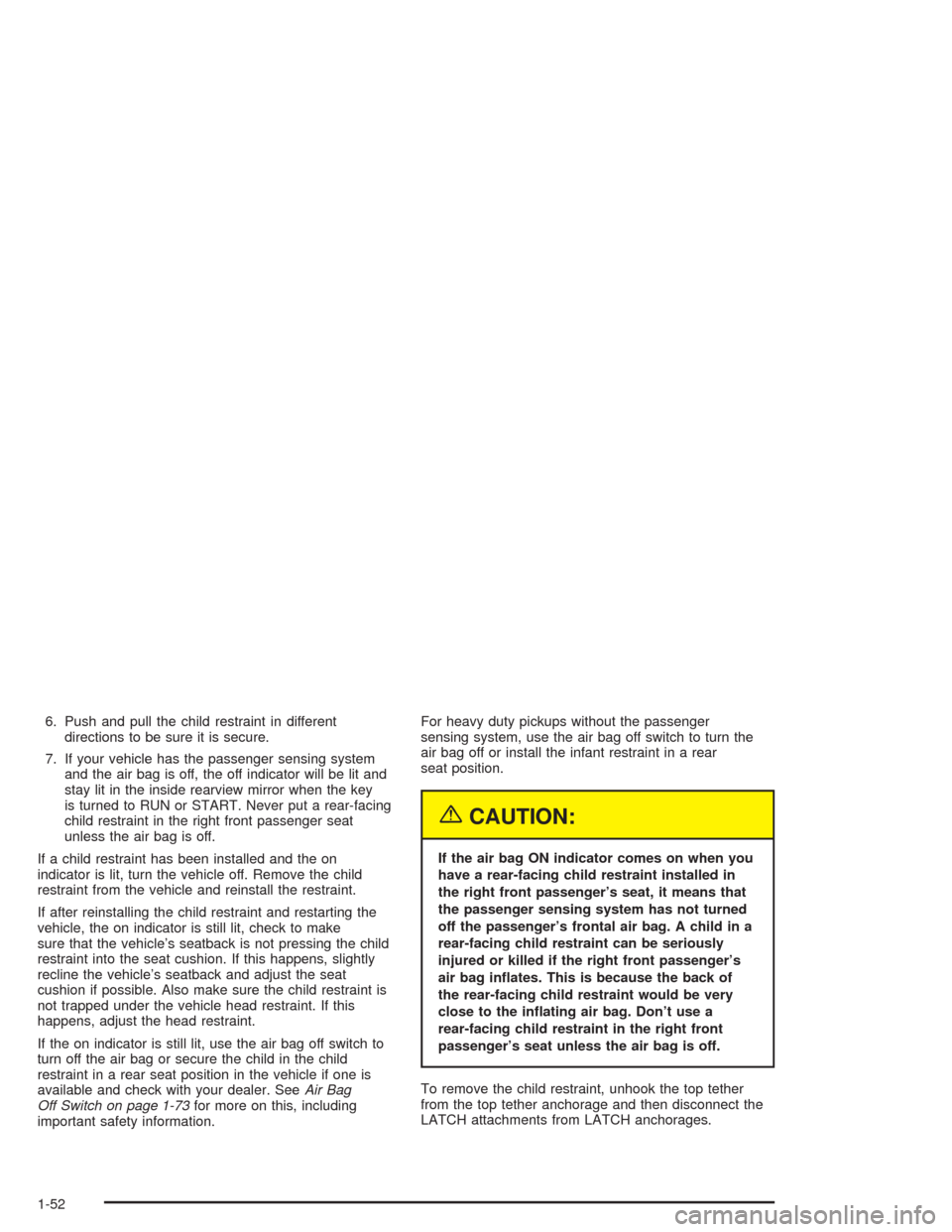
6. Push and pull the child restraint in different
directions to be sure it is secure.
7. If your vehicle has the passenger sensing system
and the air bag is off, the off indicator will be lit and
stay lit in the inside rearview mirror when the key
is turned to RUN or START. Never put a rear-facing
child restraint in the right front passenger seat
unless the air bag is off.
If a child restraint has been installed and the on
indicator is lit, turn the vehicle off. Remove the child
restraint from the vehicle and reinstall the restraint.
If after reinstalling the child restraint and restarting the
vehicle, the on indicator is still lit, check to make
sure that the vehicle’s seatback is not pressing the child
restraint into the seat cushion. If this happens, slightly
recline the vehicle’s seatback and adjust the seat
cushion if possible. Also make sure the child restraint is
not trapped under the vehicle head restraint. If this
happens, adjust the head restraint.
If the on indicator is still lit, use the air bag off switch to
turn off the air bag or secure the child in the child
restraint in a rear seat position in the vehicle if one is
available and check with your dealer. SeeAir Bag
Off Switch on page 1-73for more on this, including
important safety information.For heavy duty pickups without the passenger
sensing system, use the air bag off switch to turn the
air bag off or install the infant restraint in a rear
seat position.
{CAUTION:
If the air bag ON indicator comes on when you
have a rear-facing child restraint installed in
the right front passenger’s seat, it means that
the passenger sensing system has not turned
off the passenger’s frontal air bag. A child in a
rear-facing child restraint can be seriously
injured or killed if the right front passenger’s
air bag in�ates. This is because the back of
the rear-facing child restraint would be very
close to the in�ating air bag. Don’t use a
rear-facing child restraint in the right front
passenger’s seat unless the air bag is off.
To remove the child restraint, unhook the top tether
from the top tether anchorage and then disconnect the
LATCH attachments from LATCH anchorages.
1-52
Page 59 of 584
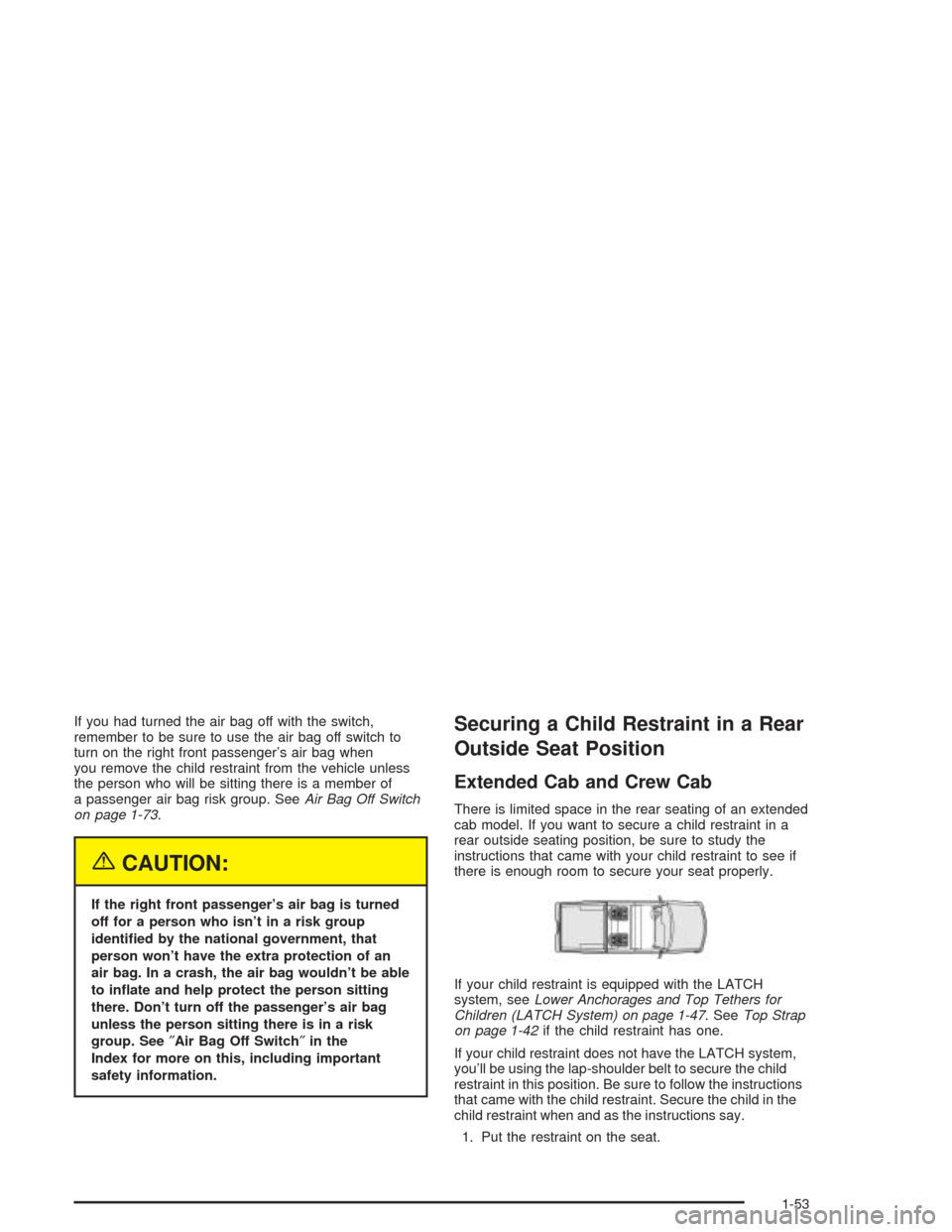
If you had turned the air bag off with the switch,
remember to be sure to use the air bag off switch to
turn on the right front passenger’s air bag when
you remove the child restraint from the vehicle unless
the person who will be sitting there is a member of
a passenger air bag risk group. SeeAir Bag Off Switch
on page 1-73.
{CAUTION:
If the right front passenger’s air bag is turned
off for a person who isn’t in a risk group
identi�ed by the national government, that
person won’t have the extra protection of an
air bag. In a crash, the air bag wouldn’t be able
to in�ate and help protect the person sitting
there. Don’t turn off the passenger’s air bag
unless the person sitting there is in a risk
group. See″Air Bag Off Switch″in the
Index for more on this, including important
safety information.
Securing a Child Restraint in a Rear
Outside Seat Position
Extended Cab and Crew Cab
There is limited space in the rear seating of an extended
cab model. If you want to secure a child restraint in a
rear outside seating position, be sure to study the
instructions that came with your child restraint to see if
there is enough room to secure your seat properly.
If your child restraint is equipped with the LATCH
system, seeLower Anchorages and Top Tethers for
Children (LATCH System) on page 1-47. SeeTop Strap
on page 1-42if the child restraint has one.
If your child restraint does not have the LATCH system,
you’ll be using the lap-shoulder belt to secure the child
restraint in this position. Be sure to follow the instructions
that came with the child restraint. Secure the child in the
child restraint when and as the instructions say.
1. Put the restraint on the seat.
1-53
Page 64 of 584
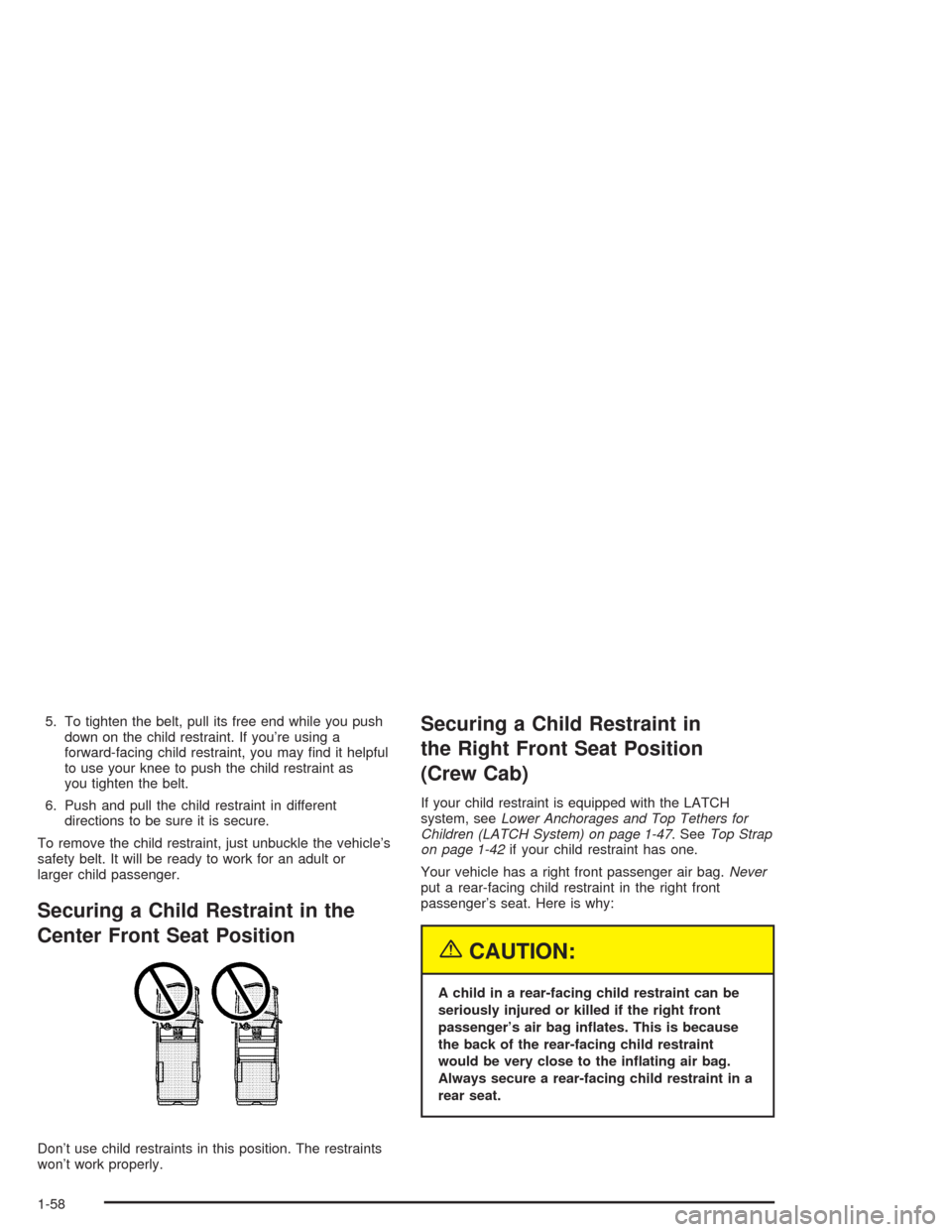
5. To tighten the belt, pull its free end while you push
down on the child restraint. If you’re using a
forward-facing child restraint, you may �nd it helpful
to use your knee to push the child restraint as
you tighten the belt.
6. Push and pull the child restraint in different
directions to be sure it is secure.
To remove the child restraint, just unbuckle the vehicle’s
safety belt. It will be ready to work for an adult or
larger child passenger.
Securing a Child Restraint in the
Center Front Seat Position
Don’t use child restraints in this position. The restraints
won’t work properly.
Securing a Child Restraint in
the Right Front Seat Position
(Crew Cab)
If your child restraint is equipped with the LATCH
system, seeLower Anchorages and Top Tethers for
Children (LATCH System) on page 1-47. SeeTop Strap
on page 1-42if your child restraint has one.
Your vehicle has a right front passenger air bag.Never
put a rear-facing child restraint in the right front
passenger’s seat. Here is why:
{CAUTION:
A child in a rear-facing child restraint can be
seriously injured or killed if the right front
passenger’s air bag in�ates. This is because
the back of the rear-facing child restraint
would be very close to the in�ating air bag.
Always secure a rear-facing child restraint in a
rear seat.
1-58
Page 65 of 584

A rear seat is a safer place to secure a forward-facing
child restraint. If you need to secure a forward-facing
child restraint in the right front seat position, seeWhere
to Put the Restraint on page 1-41.
There is no top strap anchor in the right front
passenger’s position. Do not secure a child seat in this
position if a national or local law requires that the
top strap be anchored, or if the instructions that come
with the child restraint say that the top strap must
be anchored. SeeTop Strap on page 1-42if your child
restraint has one.
You will be using the lap-shoulder belt to secure the
restraint in this position. Be sure to follow the
instructions that came with the child restraint. Secure
the child in the child restraint when and as the
instructions say.
1. Because your vehicle has a right front passenger’s
frontal air bag, always move the seat as far back as
it will go before securing a forward-facing child
restraint. SeeManual Seats on page 1-3orPower
Seats on page 1-4.
2. Put the restraint on the seat.
3. Pick up the latch plate, and run the lap and shoulder
portions of the vehicle’s safety belt through or
around the restraint. The child restraint instructions
will show you how.4. Buckle the belt. Make sure the release button is
positioned so you would be able to unbuckle the
safety belt quickly if you ever had to.
1-59
Page 67 of 584
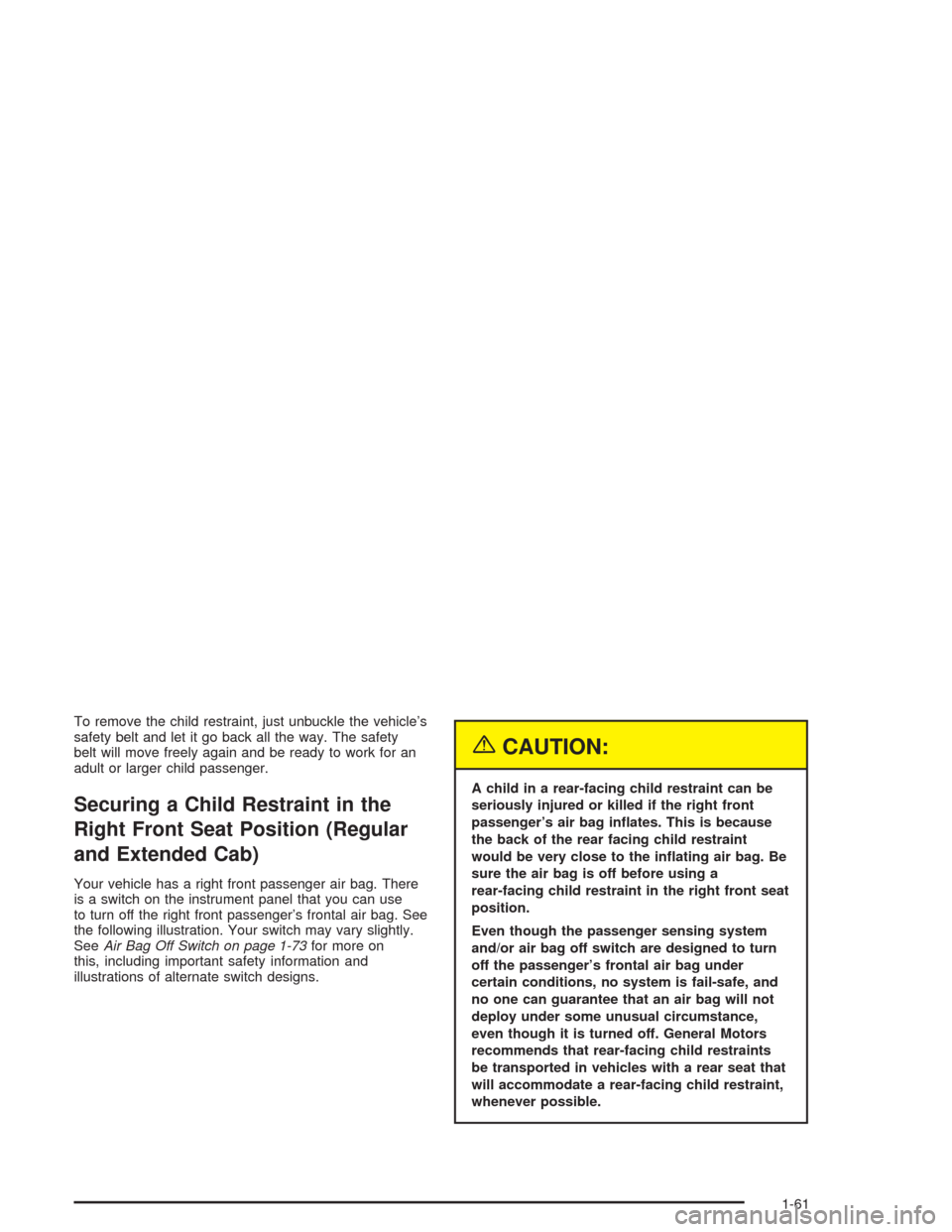
To remove the child restraint, just unbuckle the vehicle’s
safety belt and let it go back all the way. The safety
belt will move freely again and be ready to work for an
adult or larger child passenger.
Securing a Child Restraint in the
Right Front Seat Position (Regular
and Extended Cab)
Your vehicle has a right front passenger air bag. There
is a switch on the instrument panel that you can use
to turn off the right front passenger’s frontal air bag. See
the following illustration. Your switch may vary slightly.
SeeAir Bag Off Switch on page 1-73for more on
this, including important safety information and
illustrations of alternate switch designs.
{CAUTION:
A child in a rear-facing child restraint can be
seriously injured or killed if the right front
passenger’s air bag in�ates. This is because
the back of the rear facing child restraint
would be very close to the in�ating air bag. Be
sure the air bag is off before using a
rear-facing child restraint in the right front seat
position.
Even though the passenger sensing system
and/or air bag off switch are designed to turn
off the passenger’s frontal air bag under
certain conditions, no system is fail-safe, and
no one can guarantee that an air bag will not
deploy under some unusual circumstance,
even though it is turned off. General Motors
recommends that rear-facing child restraints
be transported in vehicles with a rear seat that
will accommodate a rear-facing child restraint,
whenever possible.
1-61